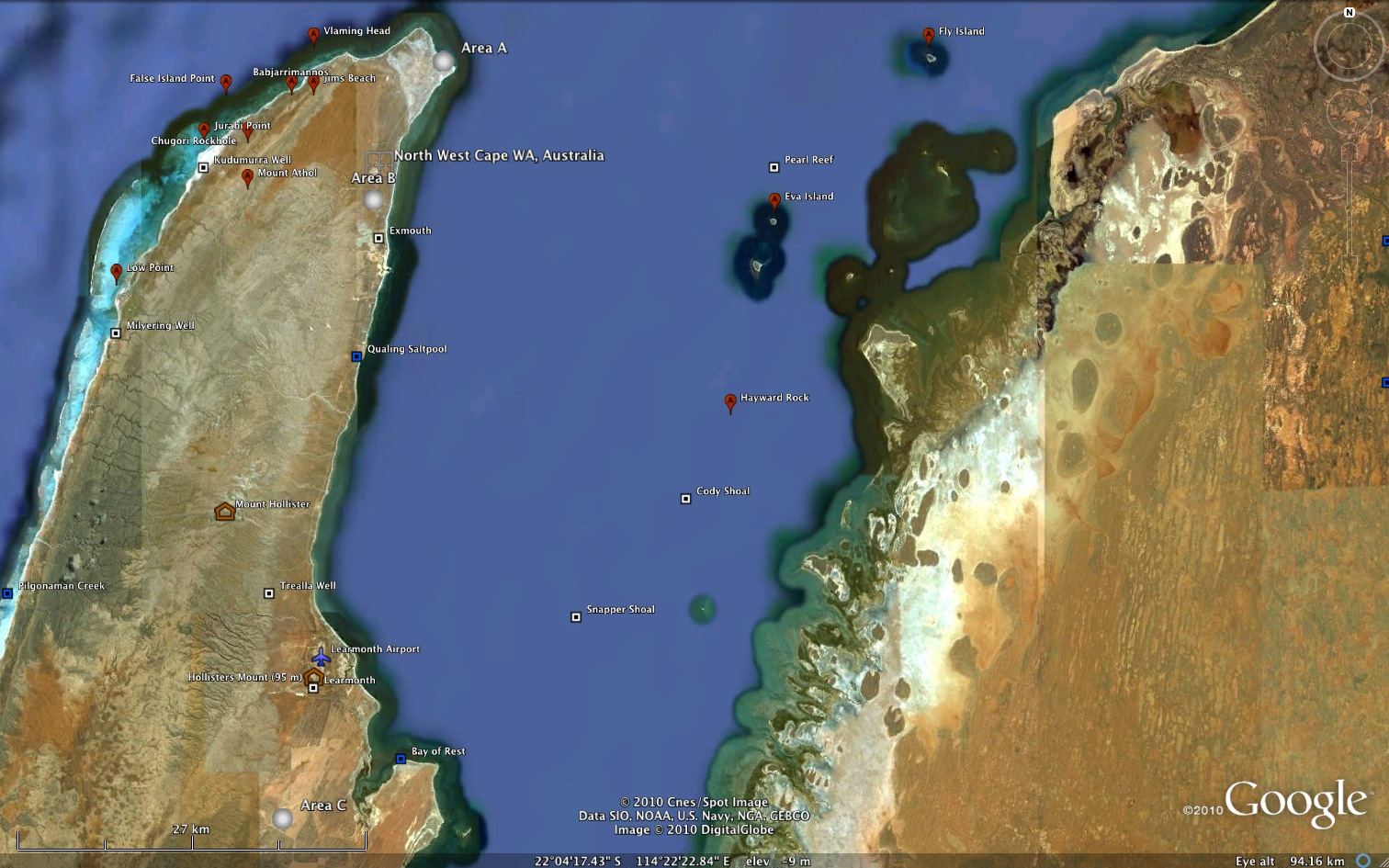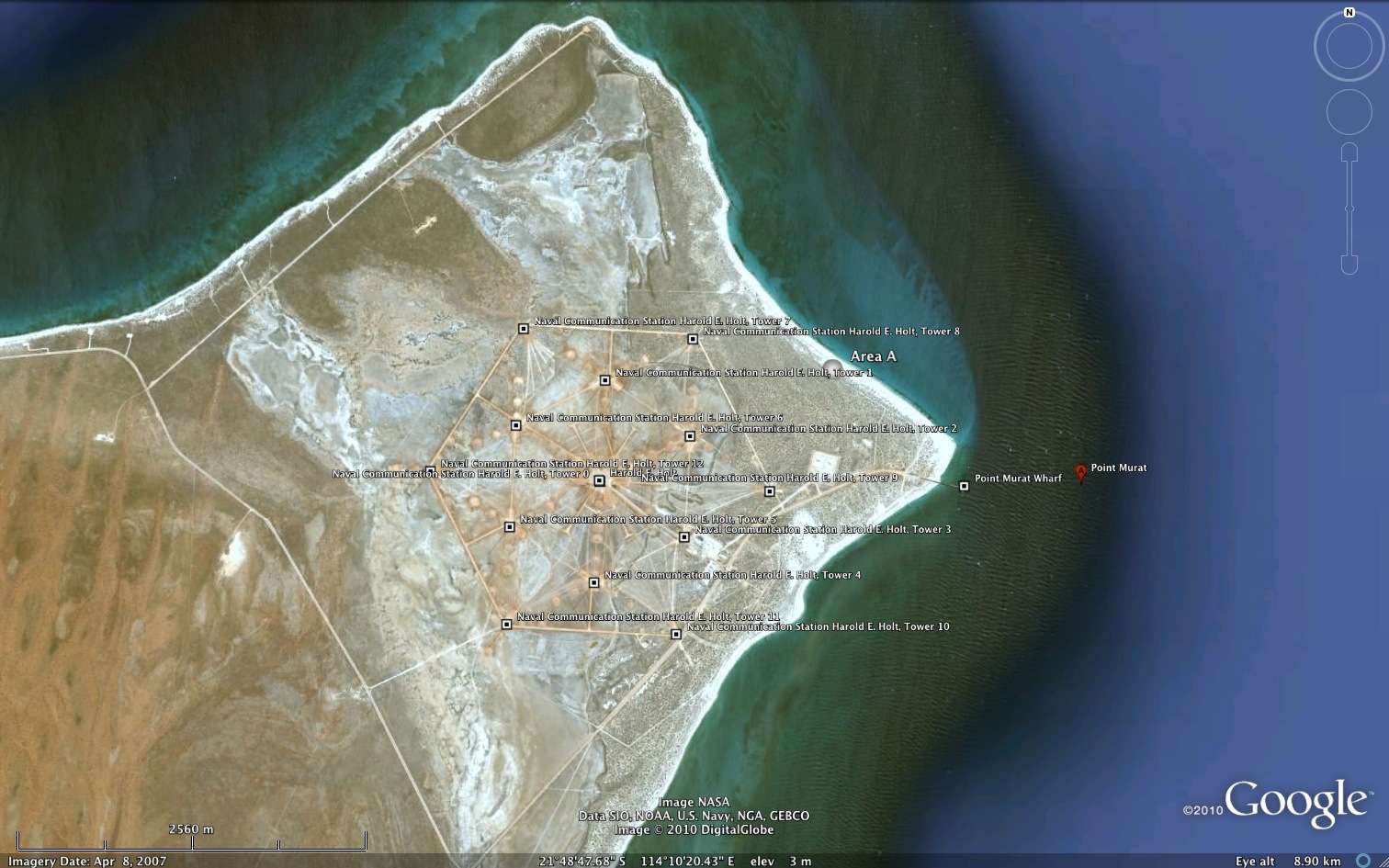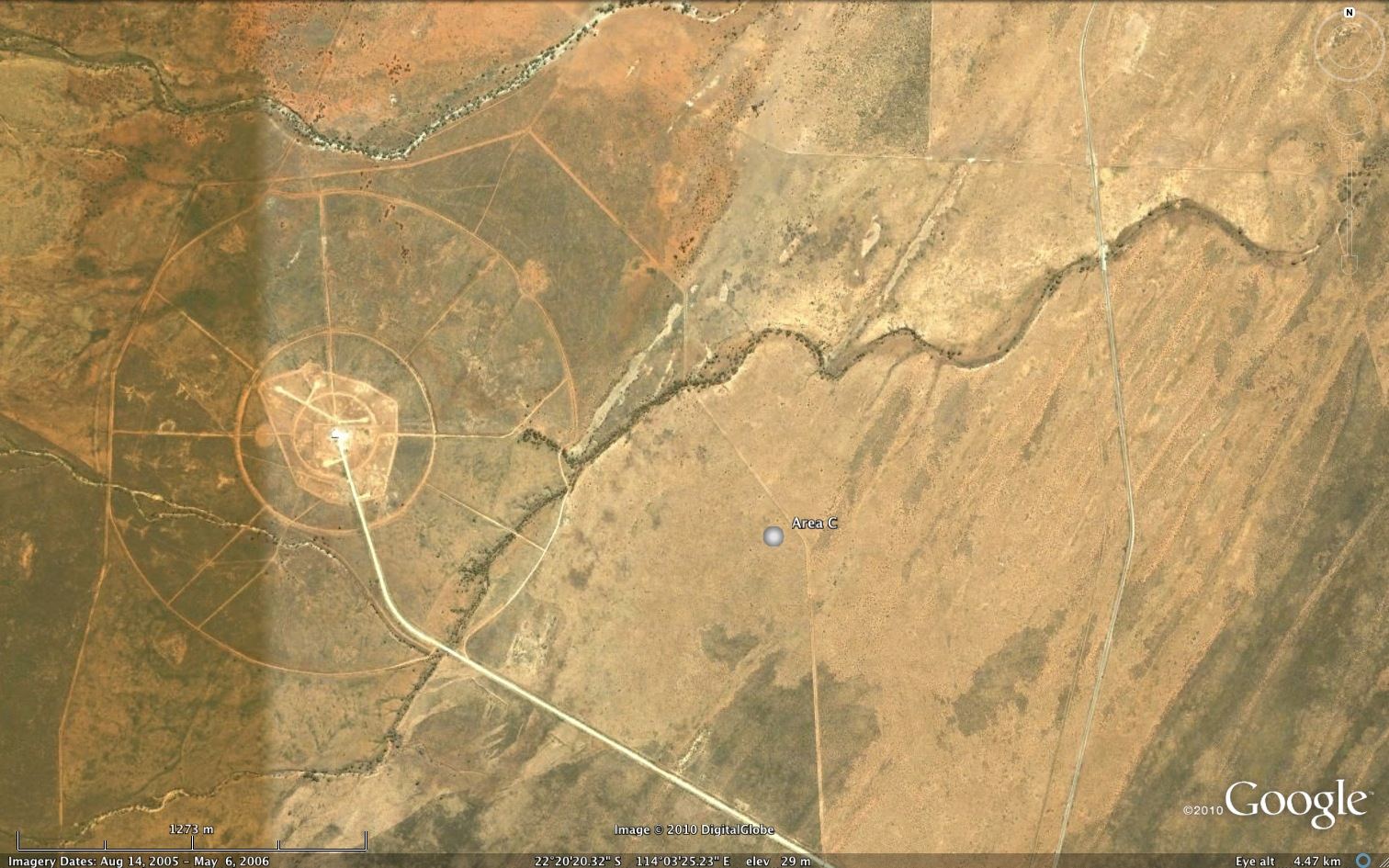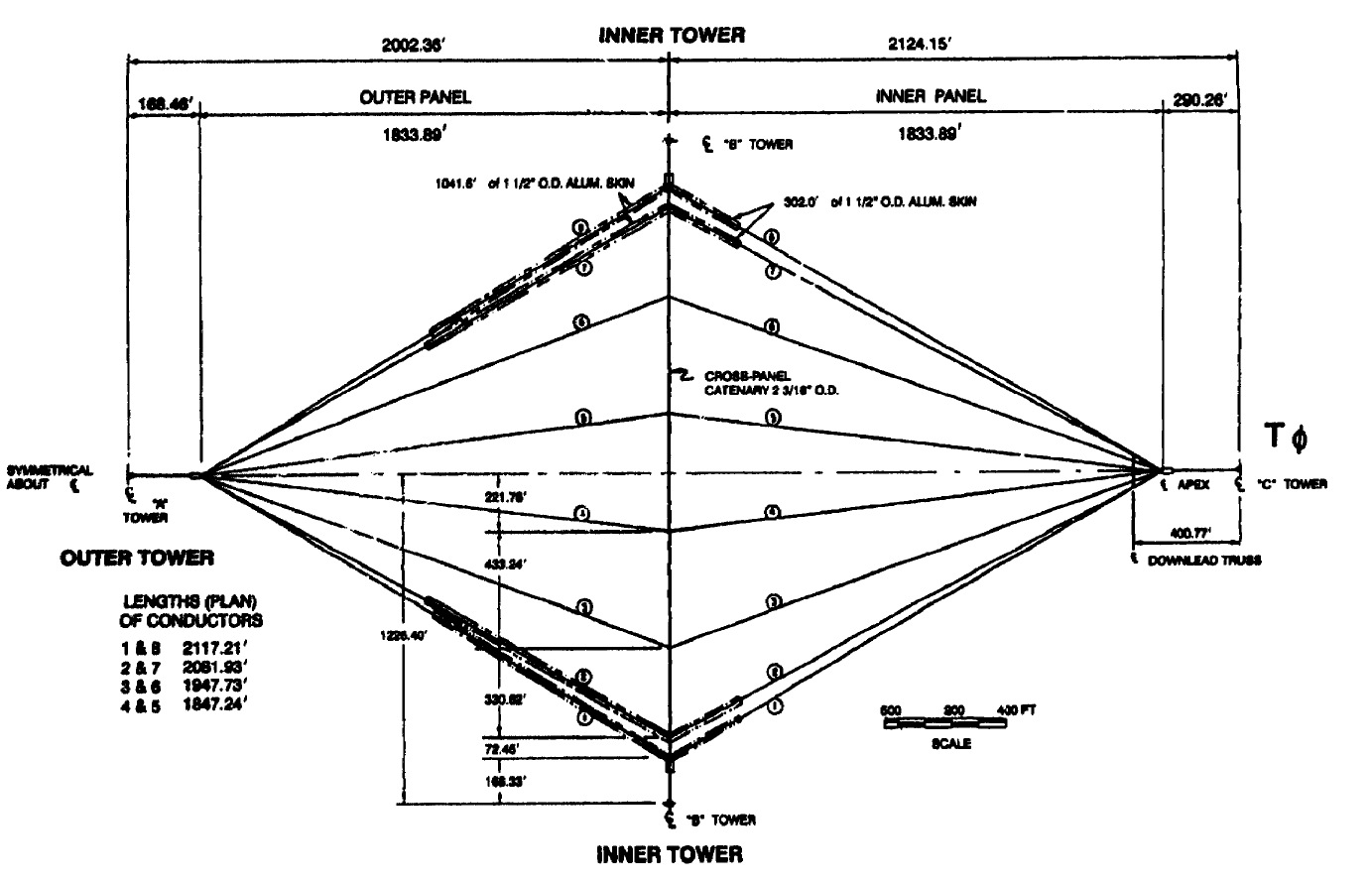Naval Communication Station Harold E. Holt (North West Cape)
Introduction
Location
Area A: 21°49’0″S, 114°10’17″E (Google Earth placemark)
Area B: 21°54’24″S, 114°7’46″E (Google Earth placemark)
Area C: 22°20’28″S, 114° 3’34″E (Google Earth placemark)
The Naval Communication Station Harold E. Holt is presently made up of three sites some 60 kilometres apart running the length of the narrow peninsula separating the Exmouth Gulf from the Indian Ocean. The original primary purpose of the US Naval Communication Station North West Cape when it opened in 1967 was to enable the US Navy to communicate with submerged submarines (and surface vessels) in the Indian Ocean and western Pacific Ocean. Two important qualities of Very Low Frequency signals is that they follow the curvature of the earth and hence can be received at great distances, and that they can be detected by receivers more than twenty metres underwater. Transmission of such Very Low Frequency radio signals required more than a million watts of power and the construction of twelve towers more than 300 metres high to support a network of antenna wires for the transmission of these powerful signals. This 400 hectare site, known as Area A, lies at the very tip of the Cape, and for more than two decades was a key link in US Navy communications, with its Polaris and other strategic nuclear missile submarines. Areas B and C hold high frequency transmission and receiving facilities further south on the peninsula, and until 1998, a Defense Satellite Communications System (DSCS) satellite communications ground station. Polaris submarines were retired from the Pacific in 1982, and were replaced by Ohio-class submarines carrying Trident nuclear ballistic missiles of much greater range, which relied principally on Jim Creek in Washington for VLF communications. But until that point, Naval Communication Station Harold E. Holt would have been a high priority Soviet nuclear target.Following the signing in May 1963 of the Agreement with the Government of the United States of America Relating to the Establishment of a United States Naval Communications Station in Australia [North West Cape – Exmouth WA], it became clear that the Australian government had no control over or access to the contents of those communications. In March 1974 the Whitlam Labor government subsequently renegotiated the base treaty, leading to the dropping of the ‘US’ from the name of the facility, and an increased but still for many years insignificant Australian presence. “In the Communications Centre, the only thing the Americans and Australians shared was the coffee pot.” During the 1980s “joint” operation came to have more substance. By 1992, the United States no longer needed direct access to the base and the long-resident Naval Security Group detachment was withdrawn in October of the year, and full command passed to the Royal Australian Navy. US personel totalled about 400, and RAN personnel about 40. In 1997 Australia took over responsibility for the facility, although US involvement and funding continued. After December 2002, operation of the station passed to the Defence Materiel organisation’s Electronic and Weapons System Division together with contractors from Boeing Australia Ltd.
In AUSMIN 2008, as part of the gathering wave of new US military, intelligence and military communications co-operation with Australia, Fitzgibbon and Gates’ signing of the Harold E. Holt Treaty, with Fitzgibbon announcing that
[T]his Treaty is yet another example of the breadth of the Australia–US Alliance. From the mountains of Afghanistan to the depths of the oceans, Australia and the United States are working together across a wide range of Defence activities aimed at maintaining a secure world.
PR language apart, Fitzgibbon was quite right. AUSMIN 2007 saw the announcement of a new ‘US strategic and military satellite communications system at the Australian Defence Satellite Communication Station (ADSCS) located at Geraldton in Western Australia’. ACDS at Kojarena, 30 km west of Geraldton, is a major signals interception station operated by the Defence Signals Division, and contributes to the worldwide Echelon system. The new joint Kojarena facility will play a key role in the Pentagon’s complex and continuously developing Global Information Grid.
Renewed and heightened US involvement in the Kojarena and North West Cape facilities for space surveillance and global military signals intelligence and communication has followed on from a decade of rapid technical and organisational developments in the global US signals intelligence interception system of which the Joint Defence Facility Pine Gap is a key part. The result is that Pine Gap, and most likely in turn Kojarena and North West Cape, are increasingly closely tied to US military operations worldwide, but particularly to operations in Iraq and Afghanistan.
The facility first known as U.S. Naval Communication Station North West Cape, is once again to become a joint Australia-United States facility. The details of the space surveillance sensor systems and radars to be installed at North West Cape and elsewhere are vague at this stage, but AUSMIN 2010 brought us a new “Space Situational Awareness Partnership” with every sign of a Chinese target.
Location:
Area A: 21°49’0″S, 114°10’17″E (Google Earth placemark)
Area B: 21°54’24″S, 114°7’46″E (Google Earth placemark)
Area C: 22°20’28″S, 114° 3’34″E (Google Earth placemark)
Government sources
Treaties, Agreements and Acts
- Agreement between the Government of Australia and the Government of the United States of America relating to the Operation of and Access to an Australian Naval Communication Station at North West Cape in Western Australia
- United States Naval Communication Station Agreement Act 1963
- Exchange of Notes constituting an Agreement with the Government of the United States of America Relating to the Establishment of a United States Naval Communications Station in Australia of 9 May 1963 [NW Cape] ?[1968] ATS 16
- Exchange of Notes constituting an Agreement to further amend the Agreement between the Government of Australia and the Government of the United States of America Relating to the Establishment of a United States Naval Communication Station of 9 May 1963 [NW Cape] ?[1975] ATS 2
- Exchange of Notes constituting an Agreement to amend the Agreement with the Government of the United States of America Relating to the Establishment of a United States Naval Communications Station in Australia of 9 May 1963 [NW Cape] ?[1982] ATS 29
- Exchange of Notes constituting an Agreement to amend the Agreement with the Government of the United States of America Relating to the Establishment of a United States Naval Communications Station in Australia of 9 May 1963, as Amended [NW Cape] ?[1992] ATS 21
- Agreement Between the Government of Australia and the Government of the United States of America Concerning Defense Communications Services, 30.10.1998
- Agreement between the Government of Australia and the Government of the United States of America Relating to the Operation of and Access to an Australian Naval Communications Station at North West Cape in Western Australia, 2008 (Harold E. Holt Treaty)
- Australia-United States Exchange of Letters Relating to Harold E. Holt Naval Communications Station, 2010
- Agreement between the Government of Australia and the Government of the United States of America relating to the Operation of and Access to an Australian Naval Communication Station at North West Cape in Western Australia
Australia
Minister For Defence meeting with US Secretary of Defense, Signing of Harold E. Holt Treaty, Joel Fitzgibbon, Minister for Defence, Media Release MIN87/08, 18 July 2008
On 15 July 2008, the Hon Joel Fitzgibbon MP, met with US counterpart, Secretary of Defense, Robert Gates, to discuss capability, international security issues, joint operations and opportunities for enhanced cooperation. At the meeting Mr Fitzgibbon and Secretary Gates signed the Harold E. Holt Treaty, which extends the existing co-operation between Australia and the United States on the Harold E. Holt Naval Communication Station located at Exmouth in Western Australia. The Harold E. Holt station provides communications for US and Australian submarines. The Station was first commissioned in 1967 and in May 1999 Australia took responsibility for the facility. This new treaty sets out the terms and conditions for the joint use of the Station for the next 25 years.
“This Treaty is yet another example of the breadth of the Australia-US Alliance. From the mountains of Afghanistan to the depths of the oceans, Australia and the United States are working together across a wide range of Defence activities aimed at maintaining a secure world,” Mr Fitzgibbon said.
Other joint facilities already hosted by Australia are the Joint Defence Facility Pine Gap and the Joint Geological and Geophysical Research Station and in addition, the US has access to the Naval Communication Station Harold E Holt. Harold E Holt is a radio relay station, passing messages between Australia and US command centres and their respective ships and submarines in the Indian Ocean and the Western Pacific. It became a joint facility in 1974 and since May 1999 it has operated as an Australian facility to which the US has full access.
United States
VLF Harold E. Holt RADHAZ Measurements, P M. Hansen and J. Chavez, Technical Report 1617, Naval Civil Engineering Laboratory, Naval Command, Control and Ocean San Diego, CA, Surveillance Center RDT&E Division 92152-5001, September 1993
The U.S. Navy VLF transmitting station HEH located at the North West Cape in western Australia is being operated by RAN. This site normally operates at a radiated power level of 1-million watts and, at times, as high as 1.8-million watts radiated. This high power causes significant levels of electromagnetic fields to exist in the vicinity of the antenna and transmitter. About 1977, while the station was under U.S. control, it was discovered that the vertical bearings on the halyard sheaves at the tower tops had frozen and needed to be repaired. The required maintenance was estimated to take nine months of downtime, which the U.S. Navy found to be unacceptable. In 1978 and 1979, Naval Ocean Systems Center (NOSC3 personnel visited the site to try and work out procedures that would reduce the downtime required for this maintenance.
At that time, with no set standards for exposure in the VLF frequency range, we concluded that reducing the fields to the point that no significant shock hazard existed would make it safe for work. Procedures were worked out that would reduce the fields; eliminate the shock hazard at the work area on the towers; allow the riggers to work on all towers except TD while transmitting; and allow for rigging and for using a winch to hoist equipment up the towers. Since this original survey, several relevant things have happened: (1) The U.S. has accepted a new standard for exposure to electromagnetic radiation; (2) HEH has changed to a new frequency, 19.8 kHz;
and (3) the station has obtained a new winch and changed the technique for rigging the winch that carries equipment up the tower.
Since then, awareness has increased of possible hazards to personnel from electromagnetic radiation. Several different U.S. and RAN agencies conducted HERP surveys at HEH. Conclusions of these surveys conflicted with each other primarily due to the use of different standards. Since RAN has taken over operation of the station, technical assistance has been requested to clear up the differences between the various HERP surveys, and revalidate the procedures for working on the towers while transmitting. In addition, the recent change of transmitting frequency from 22.3 kHz to 19.8 kHz has precipitated concern among station personnel regarding
the safety of working on the towers.ANTENNA DESCRIPTION
The VLF antenna at HEH has been named a TRIDECO type of antenna (HNCD, 1963, 1967). It is an electrically short top-loaded monopole as are all the U.S. Navy’s VLF antennas. The top-load of the HEH antenna is made up of six diamond-shaped panels. These panels are formed by eight wires that run out from the antenna center and one catenary wire for support (figure 1). An overall top view of the antenna is given in figure 2. Note that the panels are labeled A through F when viewed clockwise from above.The 6 panels are supported by 13 towers. The Lowers are positioned with one tower in the center known as TO. There are six odd-numbered Lowers (TI-T11) located on an outer ring with radius 4126 ft. There are six more even numbered towers (T2-T12) located on an inner ring centered on TO with radius 2124 ft TO is 1271 ft tall, the towers on the inner ring are 1175 ft tall, and the towers on the outer ring are 996 ft tall.The outer apex of panel A is supported by the halyard from tower T1. The center catenary of panel A is supported between T12 and T72. The feeders are labeled with letter of the corresponding panel.
The towers, also numbered clockwise, are all grounded and supported with grounded guy wires. The top-load panels are hoisted into position by 4-part halyards attached to permanent winches at the tower base. The halyards are insulated fom the panel by a string of eight Lapp com cone insulators located at the panel corners.
The transmitter and antenna tuning system are located in a building built around the base of TO. The antenna current exits this building through two feed-through bushings on the roof. The antenna current then flows in three insulated 4-wire cages, called the feed bus system, to the pulloff insulator structure s located at three points on the edge of the roof. The structure was designed to allow lowering the panels to perform maintenance. (pp. 1-4)
Analysis
A Suitable Piece of Real Estate: American Installations in Australia, Desmond Ball, Hale and Iremonger, 1980, pp.50-57
Calls to the Deep: the Story of Naval Communication Station Harold E. Holt, Exmouth, Western Australia, Brian Humphreys, Defence Publishing Service, 2006.
North by North West Cape: Eyes on China, Richard Tanter, Austral Policy Forum 10-02A, 14 December 2010; abridged version as Joint operations, Arena Magazine, December 2010
Naval Communications Station Harold E Holt (NCS HEH), GlobalSecurity.org
On May 7, 1999 Space & Naval Warfare Systems Center awarded Continental Electronics Corporation, Dallas, an Indefinite Delivery, Indefinite Quantity, Cost-Plus-Incentive-Fee type contract with an estimated amount of $5,626,886 to provide upgrades, modifications, engineering support, on-site technical services, material procurement and maintenance to extend the life of the Very Low Frequency Fixed Submarine Broadcast System sites at Cutler, Maine, Arlington (Jim Creek), Wash., Lualualei, Hawaii, Exmouth, Australia and Aguada, Puerto Rico. The scope of work includes manufacturing, assembly, integration, installation and testing. Place of performance will be the contractor’s facility in Dallas, and the five Navy sites. Period of performance for the base period shall commence May 14, 1999 through September 30, 1999. This contract contains option line items, which, if exercised, will bring the total cumulative value of the contract to $34,529,696 (total dollar amount including options).
Images and maps
See also
Project coordinator: Richard Tanter
8 March 2011






